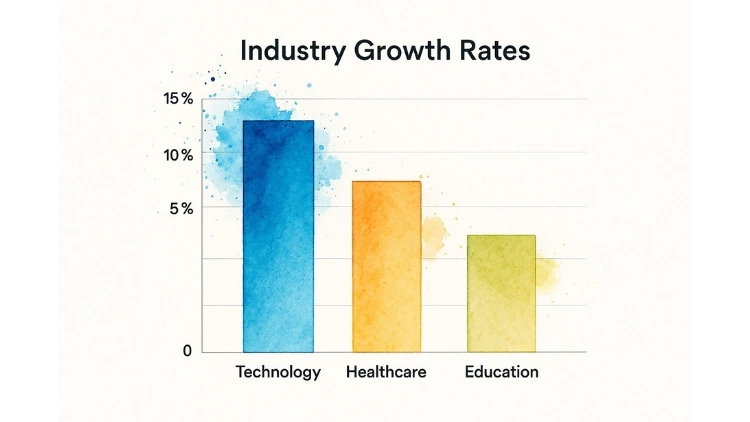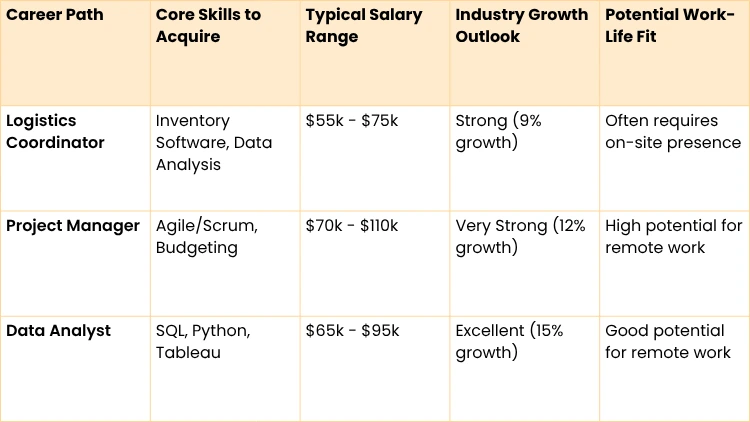How to Change Careers Without Starting All Over

Thinking about a career change is a mix of excitement and, let's be honest, a little bit of terror. The trick is to channel that energy into a plan, and every good plan starts with a reality check. Before you even think about scrolling through job boards, you need to get crystal clear on your skills, your passions, and your absolute deal-breakers.
This first step is what separates a successful pivot from an impulsive jump that lands you right back where you started.
Jump To Section

Earn As You Learn
Earn 25% commission when your network purchase Uplyrn courses or subscribe to our annual membership. It’s the best thing ever. Next to learning,
of course.
Starting Your Career Change With a Reality Check
So many career changes fizzle out, not from a lack of trying, but from a lack of clarity. It's easy to get swept up in a daydream about a new field, only to find out the day-to-day reality is just as unfulfilling as your current gig. The most lasting, successful pivots always begin with a brutally honest look in the mirror.
Before you can map out where you're going, you have to know exactly where you're standing right now. This isn't just about complaining about your boss; it's about digging deep to figure out what genuinely lights you up and what completely drains your battery.
What Drains You vs What Energizes You
Here's a practical exercise: for one full week, run an "Energy Audit" on yourself. Just grab a notebook or open a doc and create two simple columns: "Energizers" and "Drainers". At the end of each workday, jot down the tasks that fall into each category. No judgment, just observation.
- Energizers: What parts of your day made you feel sharp, engaged, or even a little bit excited? Maybe it was the 30 minutes you spent untangling a complex spreadsheet, or that quick chat where you got to mentor a junior colleague.
- Drainers: What did you dread? What left you feeling like you needed a nap? This could be anything from sitting through endless meetings to churning out the same old weekly reports.
After a week, you'll see patterns you never noticed before. A marketing manager might realize that digging into campaign data is a huge Energizer, while presenting those findings to clients is a total Drainer. That's a golden nugget of information. It points toward a potential pivot into a more analytical role—like data analysis or market research—instead of just another client-facing job.
Catalog Your Skills and Define Your Non-Negotiables
Okay, you know what fuels you. Now, let's take stock of your professional toolkit. This is more than just listing old job titles. You need to get specific and create two distinct lists for your hard and soft skills.
Hard Skills are your teachable, technical chops. Think things like:
- Software proficiency (Salesforce, Figma, WordPress, you name it)
- Fluency in a foreign language
- Coding, data analysis, or graphic design
- Project management frameworks like Agile or Scrum
Soft Skills are the interpersonal traits that dictate how you work. These are just as important.
- Public speaking and clear communication
- Leading a team and motivating others
- Solving problems when the pressure is on
- Bouncing back from setbacks (resilience!)
With your skills mapped out, it's time to draw your lines in the sand. These are your "non-negotiables"—the absolute must-haves for your next role. They'll act as your filter, saving you from wasting time on opportunities that aren't a true fit. If you're still on the fence about making a leap, some outside perspective on determining if it's time for a career change can be really helpful.
Actionable Insight: Get super specific with your non-negotiables. Don't just write "good work-life balance". Define it. Does that mean "I won't work more than 45 hours a week" or "I need the flexibility to work from home twice a week"? Instead of "a good salary", put a number on it: "a minimum of $85,000 annually to cover my expenses and savings goals."
This self-assessment is the foundation for everything that comes next. A huge part of this is also figuring out when to pull the trigger on leaving your current role; this guide on when is it the right time to quit can walk you through that decision.
Once you have this clarity, you're no longer just running away from a job you hate. You're strategically moving toward a career that actually fits your skills, your energy, and your life. That's the difference between a random jump and a true leap forward.

Exploring New Career Paths Without Paralysis
Once you've done an honest self-audit, you get to the fun part: seeing what else is out there. But let's be real, the sheer number of options can quickly turn that excitement into a serious case of analysis paralysis. The goal here isn't to boil the ocean; it's to strategically whittle down your vague "what ifs" into a focused shortlist of two or three genuinely viable career paths.
This phase is all about smart, targeted research. Instead of getting lost in endless scrolls through job boards, you'll use real data to point you toward industries that actually have a future. More importantly, you'll learn how to get the unvarnished truth about what a job is really like day-to-day, beyond the polished corporate descriptions.
Using Data to Find Growing Industries
Before you fall in love with a specific job title, you need to zoom out and look at the big picture. Some industries are booming, others are shrinking. One of the single smartest moves you can make is to place your bet on a sector that's on the upswing.
Labor market data isn’t just for economists—it's your secret weapon. Resources from government agencies and industry reports are goldmines for seeing which fields are adding jobs and which aren't. This is more crucial now than ever. The World Economic Forum predicts that between 2025 and 2030, huge structural shifts will mean about 22% of today's jobs will be either newly created or displaced. That shakeup will result in 170 million new jobs popping up worldwide, so you'll want to aim for those areas of growth. You can dive deeper into the full report on the future of jobs to get a better sense of these trends.
The chart below gives you a quick snapshot of projected growth in a few key sectors.
As you can see, while several fields are growing, tech and healthcare are expanding at a much faster clip. For someone looking to make a change, that means more doors opening and more opportunities to get in.

The Power of the Informational Interview
Okay, you’ve identified a few promising industries. Now it's time to get an insider's perspective. Enter the informational interview—a casual chat with someone working in a role or industry that’s caught your eye. Let me be clear: this is not a job interview. It's a fact-finding mission.
You’d be surprised how generous people can be with their time, especially if you approach them respectfully and make it clear you're there to learn. Your goal is to understand the reality of their job—the good, the bad, and the stuff they never put in the job description.
A few solid questions to get the ball rolling:
- "What does a typical day or week actually look like in your role?"
- "What's the most challenging part of your job that people outside the industry might not expect?"
- "Looking ahead, what skills do you think will be most critical for success in this field over the next five years?"
Actionable Example: Imagine a retail manager who, after that energy audit we talked about, realizes they actually love the inventory management and store layout part of their job—not the constant customer service. They identify logistics and supply chain management as potential growth areas. Using LinkedIn, they find a Supply Chain Analyst at a local manufacturing company and shoot them a polite message asking for 15 minutes to hear about their career path. That one conversation will give them more practical insight than hours of online research ever could.
From a Long List to a Shortlist
Now it's time to pull all your research together and get focused. This is where you move from dreamer to planner. Creating a simple comparison chart for your top contenders is one of the most powerful things you can do.
Seeing the pros and cons laid out side-by-side provides incredible clarity. If you're weighing creative fields, for instance, you might find this guide on comparing career paths like graphic design vs. video editing gives you a good template to follow.
Here’s a simple table to help you organize your thoughts and make a truly informed decision.
Side-by-Side Career Path Comparison
Use this template to organize your research and compare your top career choices based on the factors that matter most to you.
This kind of structured comparison pulls you out of a state of paralysis and puts you firmly in the driver's seat. You're no longer just vaguely wishing for a change; you're making a data-driven choice based on salary, skills, and long-term potential. This is how you set the stage for a pivot that actually sticks.

Building the Right Skills for Your New Role
So, you've pinpointed a promising new career path. Now comes the big, often intimidating question: "How do I get the skills for a job I've never actually done?" Many people get stuck here, thinking the only answer is a pricey, multi-year degree. Let me tell you, that's almost never the case.
This isn't about erasing your past experience and starting from zero. It’s about being surgical—finding the exact skills you're missing and closing that gap. We're focusing on practical, hands-on application, not just theory. This is how you build a compelling case for yourself without racking up massive debt or pausing your life for years.
Choose Your Learning Pathway
Today, you have more options than ever for picking up new skills. The trick is to find the right pathway—or maybe a mix of them—that fits your learning style, budget, and schedule. There's no single "best" option here, only what’s best for you.
Let’s walk through the most effective routes.
- Online Courses: Think platforms like Uplyrn offering expert-led courses. These are fantastic for getting a solid foundation in areas like data analytics, project management, or digital marketing. They're structured, usually self-paced, and give you the required skills to put on your resume.
- Intensive Bootcamps: If you need to get up to speed on technical skills fast, a bootcamp can be a game-changer. They're incredibly popular for fields like coding, UX/UI design, and cybersecurity. Yes, it's a serious commitment of time and money, but their project-based approach is designed to make you job-ready in a matter of months.
- Self-Directed Projects: Never, ever underestimate the power of teaching yourself. It's the most budget-friendly option and sends a powerful signal to employers that you're a self-starter who can solve problems. The whole point here is to build a portfolio that physically shows what you can do.
Practical Example: Imagine a graphic designer wants to move into UX/UI. Instead of a new degree, she signs up for a $8/month online UX certification to learn the core principles. Then, she puts it to work by redesigning the websites for two local businesses for free. Just like that, she has two powerful, real-world case studies for her portfolio.
Create a Personalized Learning Plan
A fuzzy goal like "learn to code" is a recipe for getting nowhere. You need a structured plan to make actual progress. Think of it as your own personal syllabus, built specifically for the job you want.
Start by digging into job descriptions for your target role. What tools, software, and specific skills keep popping up? Make a list. That's your curriculum. From there, you can map out how you’ll tackle each item using the pathways you just chose.
Here’s a dead-simple structure for your plan:
- Skill to Acquire: e.g., "Learn fundamental SQL for data analysis."
- Learning Resource: e.g., "Complete the 'SQL for Data Science' course on Uplyrn."
- Practical Application: e.g., "Download a public dataset and use SQL to answer three business questions."
- Timeline: e.g., "Get this done by the end of next month."
This simple trick breaks a huge, overwhelming goal into small, manageable wins. For more ideas on how to pick the right courses, this guide on finding valuable professional development online courses can help you zero in on what aligns with your goals.
Gain Practical Experience While You Learn
Theory is one thing, but employers hire people who can deliver results. The single most important part of this whole process is applying what you learn in a real-world setting. This is what makes your pivot believable to a hiring manager.
You don't have to wait until you're an "expert" to start, either. In fact, getting your hands dirty is the fastest way to become one. This is especially true now, with the job market shifting so quickly. Labor market data from the U.S. Bureau of Labor Statistics shows the fastest-growing jobs are in tech and healthcare, where being able to adapt is everything. You can check out the full employment trends report to see where the biggest opportunities are popping up.
Here are a few proven ways to get that crucial experience:
- Freelance on the Side: Pick up small, paid projects on platforms like Upwork or Fiverr. Even one small project is a legitimate entry for your resume and portfolio.
- Volunteer Your Skills: Non-profits and local community groups are almost always looking for help. Offering your new skills in marketing, web design, or bookkeeping can give you incredible experience and a glowing reference.
- Seek Internal Projects: Look for chances inside your current company. Could you volunteer to help the data team with a small analysis? Offer to manage your department’s social media? It’s a low-risk way to build experience.
When you blend structured learning with immediate, practical application, you stop being an aspiring career changer. You become a candidate with skills you can actually prove.

Networking Your Way Into a New Industry
You can have the perfect resume and all the right skills, but let's be honest: when you're changing careers, your network is often what actually gets you in the door. The good news? You don't need a massive, pre-existing list of contacts to make this work.
This is about building real, authentic relationships from scratch. It’s not about awkwardly asking strangers for a job. Forget what you think you know about old-school, stuffy networking events. Today, it’s all about strategically finding people who are already where you want to be, learning from their journey, and showing them your value long before you ever ask for a thing.
Finding and Engaging Industry Insiders
First things first, you need to become a bit of a digital detective. Your primary tool here is going to be LinkedIn, but the trick is to use it smartly—not just by sending out a hundred blind connection requests and hoping for the best.
Your goal is to find people who have either made a similar pivot themselves or who currently work at companies that pique your interest. Then, you engage with them thoughtfully.
Start by looking for alumni from your university, people in local industry groups on platforms like Meetup, or even second-degree connections. When you find someone who looks interesting, don't just smash that "connect" button. Follow them first. Pay attention to what they post about, the articles they share, and the conversations they jump into.
Doing this little bit of homework gives you context. It lets you approach them with something more meaningful than, "I'd like to connect". You can reference a recent post or a shared interest, which immediately makes your outreach feel warmer and far more personal.
Practical Example: Imagine you're an accountant trying to break into a fintech startup. You find a Product Manager at a company you're targeting. Instead of a cold message, you notice she just shared an article about the future of digital payments. You actually read the article, then leave a thoughtful comment on her post about how that trend might impact financial reporting. Then, and only then, do you send a connection request referencing your shared interest. See the difference?
Crafting Outreach Messages That Actually Get Replies
Okay, so you've done your recon. Now it's time to reach out. The absolute key to getting a reply is to make your message short, respectful of their time, and focused on learning—not asking for a job.
Your initial message should have a simple, clear structure:
- The Opener: A quick, personalized intro.
- The "Why": Explain why you're reaching out to them specifically.
- The Ask: Request a very brief, low-commitment chat. Think "15 minutes for a virtual coffee."
Here’s a simple template you can adapt:
"Hi [Name], I came across your profile while exploring the [New Industry] space and was really impressed with your work on [Specific Project]. As someone transitioning from [Old Industry], I'd love to hear a bit about your experience. Would you be open to a quick 15-minute chat sometime next week to share your insights?"
This script works because it's specific, genuinely flattering (without being creepy), and makes a clear, time-limited request. You're showing you value their time from the get-go.
Finding a Mentor to Guide Your Pivot
While those one-off informational interviews are fantastic for gathering intel, a mentor can provide the ongoing guidance that truly makes a difference. A great mentor is someone who has already walked a path similar to the one you're on and can help you sidestep the common pitfalls.
Finding a mentor usually isn't some formal, dramatic proposal. It often grows organically out of the networking you're already doing.
Maybe you have a fantastic informational interview with someone who casually says, "Feel free to reach out again if you have more questions." That's your opening. Nurture that connection. Send them periodic updates on your progress and ask thoughtful questions. For a much deeper dive, this guide on how to ask someone to be your mentor has specific strategies and scripts to help you out.
At the end of the day, building authentic relationships is the secret sauce for a successful career change. It’s not just about what other people can do for you; it's about what you can learn and how you can eventually contribute to their world, too. This mindset turns networking from a transactional chore into a genuine, and even enjoyable, part of your professional growth.
Crafting Your Story and Nailing the Interview
Okay, this is where everything comes together. All that self-reflection, research, skill-building, and networking has been leading up to this moment. Now, you’ve got to turn your career pivot into a compelling story that makes hiring managers nod their heads and think, "This makes perfect sense."
Your goal is to show them this isn't some random leap of faith. It's a deliberate, well-thought-out next step in your professional journey. Honestly, a successful career change often hinges on great storytelling. You need to connect the dots for recruiters and show them how your past experiences are not just relevant—they're a unique advantage. This is how you turn a non-traditional background into your greatest strength.
Rewriting Your Resume for a New Direction
First things first: your old resume is officially retired. For a career change, you can't just update a few bullet points; you need a complete overhaul. Think of it as writing for an entirely new audience, one that doesn't speak the language of your old industry.
The mission is simple: downplay the irrelevant job duties and put a massive spotlight on your transferable skills.
Scrub any industry-specific jargon that won't mean anything to your new audience. Instead of listing every task from your old job, zero in on the achievements that showcase skills any employer would want—things like project management, data analysis, or client communication.
Let’s see it in action:
- Before: "Managed a team of 10 retail associates, responsible for scheduling and inventory."
- After: "Led a 10-person team, driving a 15% increase in operational efficiency through strategic scheduling and inventory optimization."
See the difference? The "After" version speaks the universal language of leadership and results. To punch it up even more, add a professional summary at the top of your resume. This is your two-sentence elevator pitch that states your new goal and highlights your top 2-3 transferable skills right away.
Mastering Your Career Change Narrative
You know the question is coming. In every single interview, they'll ask, "So, why the change?" A flimsy answer here is a major red flag. What you need is a concise, confident, and positive story that frames your pivot as a natural evolution. This is your career change narrative.
Your story needs to bridge the gap between your past and your future. This isn't the time to complain about your old job. It's about explaining what you learned and how it perfectly positions you for this new challenge. Your narrative should have three main beats:
- The Origin: Briefly mention what you enjoyed and were great at in your last career.
- The Turning Point: Talk about the "aha!" moment that prompted you to explore a new path.
- The Future: Connect your old skills and new passion directly to this specific role and company.
Practical Example: Let's say a former teacher is interviewing for a corporate training role. They could say: "I loved my decade in education, especially finding ways to make complex topics click for my students. I eventually realized my true passion was in adult learning and professional development, which is why I got certified in instructional design. This role is so exciting because it lets me use my curriculum-building skills to help your employees grow and succeed."
Acing the Interview Questions
Beyond the "why" question, you have to be ready to show how your skills apply to the job, even if your experience isn't a 1:1 match. Always position yourself as a proactive problem-solver.
When they ask about a skill you don't have, please don't just say you're a "fast learner". Give them proof. Talk about that online course you just finished or the freelance project where you had to get up to speed on a new software tool under a tight deadline. Show, don't just tell.
As you get ready to meet potential employers, remember your online presence is part of the package. A great first impression matters, which underscores the importance of a strong LinkedIn profile picture. And for a deeper dive on how to frame your journey, check out this guide on the art of telling your professional story.
Negotiating and Making Your Exit
Getting the offer feels like crossing the finish line, but you're not quite done. Don't fall into the trap of thinking you have to take a pay cut just because you're switching fields. If you’ve successfully made the case for your skills, you have leverage. Research the salary bands for the position and be ready to explain why your unique background is worth a competitive offer.
Leaving a job for better alignment is becoming the norm. The 2025 Deloitte Global Gen Z and Millennial Survey found that work-life balance and learning opportunities are top priorities, with only 6% of Gen Z even aiming for a senior leadership role. They’re more interested in growth. You can use this to your advantage—if the salary is rigid, try negotiating for a professional development stipend.
Finally, leave your current job gracefully. Give plenty of notice, create documentation to help your team, and resist any urge to vent. The professional world is surprisingly small. A classy exit protects your reputation and your network, putting a professional cap on a successful career change.

Got Questions About Changing Careers? You're Not Alone.
Thinking about a career change can bring up a storm of questions and a healthy dose of anxiety. That's totally normal. Let's get straight to the big ones and tackle them with some practical, real-world advice.
"Am I Too Old to Switch Careers?"
Let’s reframe that. The answer is a hard no. What you might see as "age" is actually your secret weapon in the job market. Decades in the workforce give you a level of maturity, wisdom, and battle-tested problem-solving skills that younger candidates just haven't had the time to build. Many employers are desperate for that kind of stability.
The trick is all in how you tell your story. Don't hide your experience—highlight the timeless, transferable skills you've spent years mastering:
- Real Leadership: You've probably guided teams, mentored junior staff, and put out fires. That's invaluable.
- Complex Project Management: Juggling deadlines, budgets, and difficult stakeholders is second nature to you.
- Proven Resilience: You’ve seen industries shift, companies pivot, and technologies come and go. You know how to adapt.
The very fact that you're learning new skills for this pivot proves you have the drive to succeed. I've seen countless people make successful switches well into their 40s and 50s by turning their life experience into their biggest selling point.
Practical Example: A retail store manager in her late 40s decided to move into human resources. She didn't have an HR degree, but she had years of hands-on experience hiring, training, and managing employee conflicts. She leaned into that, landing a great role as an HR Generalist because her practical management skills were far more valuable than any textbook theory.
"How Do I Deal With a Potential Pay Cut?"
Okay, this is a big one. A temporary dip in salary is a real possibility, but it shouldn't be a dealbreaker. It’s all about playing the long game. First things first: get brutally honest with your finances. Create a detailed budget to figure out the absolute minimum you need to live on. This isn't just a number in your head; it's your negotiation floor.
Next, look beyond the starting salary. A 10% pay cut right now might sting, but what’s the earning potential in your new field in three to five years? If the new path has a much higher ceiling, that short-term sacrifice is actually a smart investment in your future. And don't forget to negotiate for things beyond the paycheck—ask for a professional development budget, more vacation days, or a flexible remote work policy. These perks can easily make up for a slightly lower starting figure.
"How Can I Get Experience in a New Field When I Have No Experience?"
Ah, the classic chicken-and-egg problem. It feels like a catch-22, but it's easier to solve than you think. If you can't get hired to do the work, you have to create your own experience. It’s about being scrappy.
Here are a few ways to do it:
- Volunteer Your Skills: Find a local non-profit or a cause you're passionate about and offer your new skills for free. You'll get real-world results for your portfolio and a fantastic reference.
- Hunt for Freelance Gigs: Jump on platforms like Upwork or Fiverr and find small, paid projects. Even one completed project is a legitimate portfolio piece and a powerful story to tell in an interview.
- Start a Passion Project: Want to get into content marketing? Start a blog. Aiming for a job in data analytics? Find a public dataset online and publish your analysis.
Honestly, these hands-on projects are often more compelling to a hiring manager than a line on a resume. They show you have initiative, you're passionate, and you can actually deliver.
Ready to build the skills for your next chapter? At Uplyrn, we provide the expert-led courses and mentorship you need to make your career change a reality. Explore our learning pathways and start your journey today.


Leave your thoughts here...
All Comments
Reply